The False Fossil Archaeoraptor: An Example of Evolutionist Fanaticism
With the collapse of their claims about Archaeopteryx, evolutionists are at a complete dead-end regarding the origin of birds. According to their claims, the Earth's geological strata should contain a great many odd fossil creatures bearing the features of both reptiles and birds. Therefore, some evolutionists have set about creating their own alleged intermediate forms, which they have been unable to find elsewhere, by resorting to biased interpretations and distortions.
The half-dinosaur, half-bird fossils described as those of "dino-birds" introduced to the public in the 1990s, are a result of these endeavors. By publishing drawings of these so-called dino-birds, evolutionist media engaged in an international campaign of deception. Each of the so-called "intermediate form fossils" portrayed as evidence for Darwinism was put forward with misleading explanations, with no scientific reservations.
Subsequently, it emerged that this campaign was based on fraud and distortion. But how can world-famous scientific journals and television institutions turn biased interpretations of fossils into a propaganda vehicle? How can they portray falsehoods uttered in the name of science as "the greatest evidence for evolution"? The answers lie hidden in the evolutionist fanaticism of these media organizations.
Let us now examine some instances:
A Historic Evolutionist Fraud: Arcaeoraptor Lianingensis
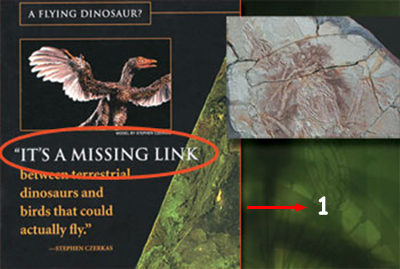 |
| 1. This imaginary reconstruction, declared to be a so-called missing link, was recognized as a forgery. |
Archaeoraptor liaoningensis was a counterfeit dino-bird fossil alleged to be an intermediate form. The remains of this creature were discovered in the Chinese province of Liaoning. Later, scientists invited to analyze it raised doubts as to its authenticity. It was determined that the fossil—had been tampered with. Yet all this was ignored, and the fossil was bought on the Chinese black market for $80,000 by Stephen Czerkas, an American museum staffer with no scientific research to his name, and illegally smuggled out of China, as are so many other specimens.
Stephen Czerkas then applied to scientific journals to publish articles about the fossil. Two magazines he contacted, Nature and Science, stated they would not publish the report until initial examinations had been carried out under paleontological rules.
Czerkas was determined to have the fossil publicized, however, and ignored the objections, submitting it to National Geographic magazine, well-known for its support for the theory of evolution.
National Geographic was well aware that under Chinese law, it was illegal for the fossil to be taken out of the country, and fossil smuggling was declared a severe crime sometimes even punishable by death. 152 Even so, the magazine accepted the smuggled fossil and introduced it to the media at a press conference at the magazine's headquarters in October 1999. National Geographic used the seven-page report relating the dino-bird myth as its November 1999 cover story, suggesting that the claim that birds had evolved from dinosaurs now rested on concrete fossil evidence.
The author of the article, National Geographic writer Christopher P. Sloan, believed so strongly in his interpretation that he wrote: "we can now say that birds are theropods just as confidently as we say that humans are mammals."
This species, said to have lived 125 million years ago, was given the scientific name of Archaeoraptor liaoningensis. The fossil was put on display in the National Geographic's museum and depicted to visitors as evidence for evolution.
The University of Kansas paleontologist Larry Martin commented on the forced interpretation and biased nature of this feathered dinosaur by saying, "To the people who wrote the paper, the chicken would be a feathered dinosaur." 153
The claim that A. liaoningensis constituted a missing link between dinosaurs and birds turned into a scandal when it emerged in March 2001 that the fossil was a forgery. No such intermediate species as Archaeoraptor had ever existed. Computer tomographic scanning of the fossil revealed that it consisted of parts from at least two different species. Archaeoraptor had a reptile-like tail and a bird-like body, which had subsequently been expertly assembled together.
Archaeoraptor was thus removed from the scientific literature and placed alongside all the other evolutionist forgeries. Darwinism, unable to find any evidence for its claims for 150 years, had again resorted to deliberately manufactured fossils.
Many articles refer to Archaeoraptor and Piltdown Man in the same breath, but there is an important difference between these two fossil forgeries, the Piltdown Man skull was accepted by scientific circles in 1912 and spent the next 40 years being portrayed as evidence of human evolution, before being exposed as a fraud. The Archaeoraptor fossil did not get that far, because some scientists doubted it right from the outset—doubts that turned out to be correct.
This forgery was said to date as far back as the Cretaceous Period, 142 to 65.5 million years ago. This carnivore also had sharp claws and teeth. Its shoulder girdle and breastbones were identical to those of present-day birds, showing that it was capable of flight.
This totally feather-covered creature walked on two legs, its bones were hollow, and it had feathers and a long tail. Yet that tail had been taken from another fossil. In 1999, it finally emerged that this dino-bird fossil was a forgery, produced by adding a bird's skeleton to a reptile backbone: The long tail of a dromaeosaurid theropod dinosaur fossil had been added to the fossil of a bird about the size of a turkey. The fact is, however, that dinosaur and avian characteristics had been deliberately combined in this fossil, created by the expert assembly of components belonging to five different living things. Chinese amateurs had made a dino-bird out of 88 bones using adhesives and various plasters. Earlier reports published under the captions like "Winged Dinosaur Found" and "Flying Dinosaur Unearthed" now gave way to "Dino-Bird Exposed" headlines. In a reference to the earlier Piltdown Man fraud, the well known magazine New Scientist began referring to the fossil as "the Piltdown Bird"! 154
NEWSPAPER REPORTS OF 16 MARCH 1999 EVOLUTIONIST PROPAGANDA MADE BY MEANS OF DINO-BIRD FOSSIL | BUT THE TRUTH LEVEALED TWO YEARS LATER...IN NEVSPAPER REPORTS DATED 29 MARCH 2001 |
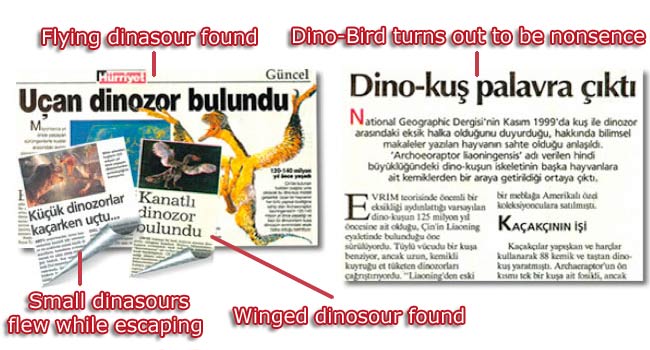 | |
| A group of researchers, including three paleontologists, examined the Archaeoraptor liaoningensis fossil with the help of computer tomography. It emerged that this supposed dino-bird fossil was composed of 88 bones and stones, put together by Chinese smugglers using adhesive and plaster. | |
On 29 March, 2001, an important admission appeared in a number of daily newspapers. The Turkish daily Hürriyet, for example, carried the story under the headline, "Dino-Bird Turns out to Be Nonsense":
It has been realized that the animal described in scientific articles and declared in National Geographic magazine in November 1999 to be a missing link between dinosaurs and birds, is a forgery. It has emerged that the turkey-sized dino-bird skeleton known as Archaeoraptor liaonongensis was actually an assembly of bones from other animals. It was suggested that the dino-bird, assumed to shed light on an important gap in the theory of evolution, was 125 million years old and found in the Chinese province of Liaoning. Its feathered body looks like a bird, although its long, bony tail was reminiscent of carnivorous dinosaurs. An examination published in today's edition of the British scientific weekly magazine Nature has revealed that the dino-bird is a fabrication. A group of researchers including three paleontologists proved the fabrication by means of computer tomography. The dino-bird was actually the work of Chinese smugglers . . . [who] smugglers constructed the dino-bird out of 88 bones using adhesives and plaster. The front of the Archaeoraptor belonged to a single bird, while the body and tail contained bones from four different species. Scanning of the dino-bird by computer indicated that the bird skeleton belonged to previously unknown species, and the dino part to new, small dinosaur species. 155
National Geographic, on the other hand, published only a very brief reference to this fabrication. This statement, by the vertebrate paleontologist Xu Xing of the Beijing Chinese Academy of Sciences, appeared in the "Forum" section, toward the back of the magazine. Xu Xing's letter contained the following statements:
After observing a new feathered dromaeosaur specimen in a private collection and comparing it with the fossil known as Archaeoraptor, I have concluded that Archaeoraptor is a composite. The tail portions of the two fossils are identical, but other elements of the new specimen are very different from Archaeoraptor, in fact more closely resembling Sinornithosaurus. Though I do not want to believe it, Archaeoraptor appears to be composed of a dromaeosaur tail and a bird body. 156
In a statement in New Scientist, however, Xu Xing says: "The Archæoraptor is composed of a bird body and a dinosaur tail."157 Larry Martin, the Kansas University expert on fossil birds, maintains that the Chinese farmers who first discovered the fossils stuck part of a dinosaur fossil onto a bird fossil: "Once you cut out the dinosaur part, it probably will be an interesting bird."158 He also thinks that the portions of this fossil may be one of the oldest examples of modern birds.
Zhonghe Zhou and Fucheng Zhang of the Vertebrate Paleontology and Palaeoanthropology Institute in Beijing and Julia A. Clarke of New York's American Museum of Natural History carried out a study comparing the Archaeoraptor fossil with a prehistoric bird from the species Yanornis martini. According to the team's report, in terms of size and anatomy, this false fossil's forelegs, fingers and beak tip bore a close resemblance to the Yanornis martini bird fossil.
In short, Archaeoraptor was a fabrication, used by the press as propaganda for the theory of evolution. This forgery must also be regarded as an indication of evolutionists' despair. Not a single intermediate form fossil has been found for more than a century, and the huge morphological differences between fossils that belong to unique species have once again left evolutionists in a dead end.
As long as Darwinists refuse to face facts, they will continue to cling to a theory kept on its feet by fraud.
1 November 1999
Dear Peter,
I thought that I should address to you the concerns expressed below because your committee is at least partly involved and because you are certainly now the most prominent scientist at the National Geographic Society.
With the publication of "Feathers for T. rex?" by Christopher P. Sloan in its November issue, National Geographic has reached an all-time low for engaging in sensationalistic, unsubstantiated, tabloid journalism. . . .
...This is the worst nightmare of many zoologists—that their chance to name a new organism will be inadvertently scooped by some witless journalist. Clearly, National Geographic is not receiving competent consultation in certain scientific matters.
Sloan's article explicitly states that the specimen in question is known to have been illegally exported and that "the Czerkases now plan to return it to China." In Washington, in June of 1996, more than forty participants at the 4th International Meeting of the Society of Avian Paleontology and Evolution, held at the Smithsonian Institution, were signatories to a letter to the Director of the Chinese Academy of Sciences that deplored the illegal trade in fossils from China and encouraged the Chinese government to take further action to curb this exploitation.
...Thus, at least since mid-1996 it can hardly have been a secret to anyone in the scientific community or the commercial fossil business that fossils from Liaoning offered for sale outside of China are contraband.
Most, if not all, major natural history museums in the United States have policies in effect that prohibit their staff from accepting any specimens that were not legally collected and exported from the country of origin. The National Geographic Society has not only supported research on such material, but has sensationalized, and is now exhibiting, an admittedly illicit specimen that would have been morally, administratively, and perhaps legally, off-limits to researchers in reputable scientific institutions.
Prior to the publication of the article "Dinosaurs Take Wing" in the July 1998 National Geographic, Lou Mazzatenta, the photographer for Sloan's article, invited me to the National Geographic Society to review his photographs of Chinese fossils and to comment on the slant being given to the story. At that time, I tried to interject the fact that strongly supported alternative viewpoints existed to what National Geographic intended to present, but it eventually became clear to me that National Geographic was not interested in anything other than the prevailing dogma that birds evolved from dinosaurs.
Sloan's article takes the prejudice to an entirely new level and consists in large part of unverifiable or undocumented information that "makes" the news rather than reporting it. His bald statement that "we can now say that birds are theropods just as confidently as we say that humans are mammals" is not even suggested as reflecting the views of a particular scientist or group of scientists, so that it figures as little more than editorial propagandizing. This melodramatic assertion had already been disproven by recent studies of embryology and comparative morphology, which, of course, are never mentioned.
More importantly, however, none of the structures illustrated in Sloan's article that are claimed to be feathers have actually been proven to be feathers. Saying that they are is little more than wishful thinking that has been presented as fact. The statement on page 103 that "hollow, hairlike structures characterize protofeathers" is nonsense, considering that protofeathers exist only as a theoretical construct, so that the internal structure of one is even more hypothetical.
The hype about feathered dinosaurs in the exhibit currently on display at the National Geographic Society is even worse, and makes the spurious claim that there is strong evidence that a wide variety of carnivorous dinosaurs had feathers. A model of the undisputed dinosaur Deinonychus and illustrations of baby tyrannosaurs are shown clad in feathers, all of which is simply imaginary and has no place outside of science fiction.
The idea of feathered dinosaurs and the theropod origin of birds is being actively promulgated by a cadre of zealous scientists acting in concert with certain editors at Nature and National Geographic who themselves have become outspoken and highly biased proselytizers of the faith. Truth and careful scientific weighing of evidence have been among the first casualties in their program, which is now fast becoming one of the grander scientific hoaxes of our age—the paleontological equivalent of cold fusion. If Sloan's article is not the crescendo of this fantasia, it is difficult to imagine to what heights it can next be taken. But it is certain that when the folly has run its course and has been fully exposed, National Geographic will unfortunately play a prominent but unenviable role in the book that summarizes the whole sorry episode.
Sincerely,
Storrs L. Olson
Curator of Birds
National Museum of Natural History
Smithsonian Institution
Washington, DC 20560 159
The Deliberate Ignoring of Archaeoraptor's Fraudulent Nature
Dr. Storrs L. Olson, director of the avian department of the famous Smithsonian Institute in the USA, stated that he had warned National Geographic beforehand that the Archaeoraptor liaoningensis fossil was a fake, but that the magazine's management had completely ignored him. These statements of Olson's appeared in an open letter to Peter Raven, a scientist called on the National Geographic staff:
In a statement to the newspaper USA Today, Olson said: "The problem is, at some point the fossil was known by Geographic to be a fake, and that information was not revealed." 160
In short, despite the realization that the fossil it portrayed to the entire world as evidence of evolution was a fake, National Geographic continued to portray it as evidence of evolution.
This deception exhibited by National Geographic is by no means the first carried out in the name of evolution. Ever since the theory was first proposed, a great many fabrications have been perpetrated to support the theory.
The German biologist Ernst Haeckel produced false embryo drawings in order to support Darwinism. British evolutionists mounted an orangutan jaw onto a human skull and displayed this for some 40 years at the Natural History Museum as "Piltdown Man—the Greatest Proof of Evolution."
American evolutionists declared a single pig's tooth to have come from Nebraska Man. All over the world, primitive creatures or ape-men that never existed have been depicted through illustrations or models billed as "reconstructions."
In light of all this, if Archaeoraptor is a fabrication, what about the other "dino-bird" fossils?
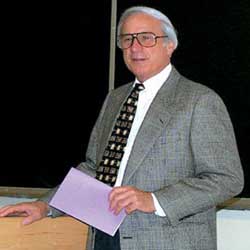 |
| Professor Alan Feduccia |
Following are extracts from an interview with Alan Feduccia published in the February 2003 edition of Discover magazine. Despite being an evolutionist, Feduccia states that the fossils discovered are not evidence of evolution and some people have resorted to fabrication:
Discover: Some recent dinosaur fossils from China have a downy, featherlike covering. Doesn't that prove a link between dinosaurs and birds?
FEDUCCIA: People have accepted that these filamentous structures—dino fuzz—represent proto-feathers. But these things do not resemble feathers, and I don't think they have anything to do with feathers. To me, they look like preserved skin fibers. . . . You can transform bird scutes [the scales on birds' feet] into feathers with the application of bone morphogenic protein. So while people imagining models for the evolution of feathers feel that filaments must be an intermediate step between scales and feathers, you really don't need that stage. ...When we see actual feathers preserved on specimens, we need to carefully determine if we are looking at secondarily flightless birds that have retained feathers and only superficially resemble dinosaurs, or if the specimens are in fact related to dinosaurs. That's a difficult issue to deal with right now, given the existence of fake fossils.
Discover: So far, only one feathered dinosaur, Archaeoraptor, has been publicly acknowledged as a forgery. You think there are others?
FEDUCCIA: Archaeoraptor is just the tip of the iceberg. There are scores of fake fossils out there, and they have cast a dark shadow over the whole field. When you go to these fossil shows, it's difficult to tell which ones are faked and which ones are not. I have heard that there is a fake-fossil factory in northeastern China, in Liaoning Province, near the deposits where many of these recent alleged feathered dinosaurs were found.
Journals like Nature don't require specimens to be authenticated, and the specimens immediately end up back in China, so nobody can examine them... there is no way to authenticate any of this stuff.
Discover: Why would anyone fake a fossil?
FEDUCCIA: Money! The Chinese fossil trade has become a big business. These fossil forgeries have been sold on the black market for years now, for huge sums of money. Anyone who can produce a good fake stands to profit.
A Forget Fossil: Archaeoraptor Liaoningensis |
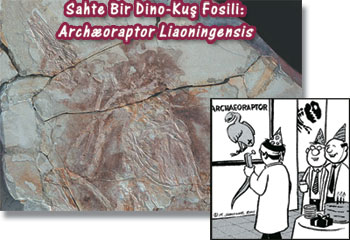 |
| An evolutionist deception: a dinosaur tail mounted onto a bird body. |
Discover: If there are good reasons to be skeptical, why are you perceived as being on the scientific fringe?
FEDUCCIA: The idea of being able to watch living dinosaurs by looking out at the birds in your backyard bird feeder is very appealing. The popular press naturally jumped all over it. It's also a money game. Many museums have promoted the idea of birds being living dinosaurs, and they have spent huge amounts of money on exhibits about that link. Plus, some paleontologists have spent three decades saying that birds evolved from dinosaurs, so there are careers at stake.
Discover: Is there anything that would convince you birds really did evolve from dinosaurs?
FEDUCCIA: At the time period when birds are thought to have evolved, there are plenty of theropod dinosaurs, but they do not have the key birdlike features.
Discover: How did you get involved in the debate in the first place?
FEDUCCIA: I really was not interested in the origin of birds until I wrote a book called The Age of Birds back in 1980, for which I had to write a chapter on bird origins. I tried to be as fair as possible, but when I did not come down firmly on the side of the dinosaurian origin of birds, I was viewed as a heretic..
If these researchers were so convinced that they were right, why did it make a difference what I thought? Why did they get so enraged? As the years progressed, I started looking into the problem of the origin of birds in great detail, and everywhere I looked, it was as if we were being asked to put a square peg in a round hole. 161
Even if dino-bird fossils are not forgeries, there is still significant evidence that the structures in them depicted as feathers have nothing to do with real bird feathers—as you'll see in the pages that follow. The subject of fabricated fossils also appeared in the British magazine New Scientist:
Most of the beautiful Chinese fossil birds on sale have been embellished in one way or another. Some may be assembled from broken pieces of several fossils, while others have had missing features added. "Almost every one that I've seen on the commercial market has some reconstruction to make it look prettier," says Kraig Derstler, a palaeontologist at the University of New Orleans in Louisiana.
Many early palaeontologists saw nothing wrong with adding a missing bone or two. Both the American Museum of Natural History and the Carnegie Museum in Pittsburgh acquired fossil skeletons of Apatosaurus with skulls from different dinosaurs in the 1880s. But the prices that well-preserved Chinese bird fossils fetch have made faking extremely profitable. Over the past twenty years, says Derstler, "adhesives and fake rock have become very easy to make and very difficult to spot."
The problems start with the Chinese peasants who dig up to make a fortune from fossils. 162
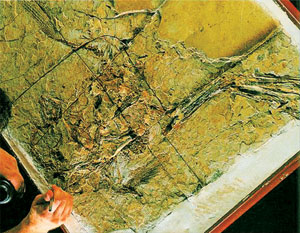 |
| Some scientists blindly place every fossil they find within an imaginary evolutionary family tree. As a result of their bias, fossil forgeries are accepted as evolutionary propaganda without being sufficiently studied. This distances them from any claim to being scientific proof. |
The next part of the report refers to how some composites, or combined fossils, were made with such expertise as to deceive even the experts:
The paleontologist Luis Chiappe, of the natural History Museum of Los Angeles County, describes how one such specimen almost fooled him, till he noticed that one leg was longer than the other. "I wasn't sure what was wrong with it." Chiappe said. Only close examination revealed that two slabs had been mortared together. "On the surface, you really couldn't see that." Dr. Larry Martin of the University of Kansas, commented, "I don't trust any of these specimens until I see X-rays." 163
Larry Martin describes the Chinese attitude regarding these forgeries:
The farmers do not believe this is wrong, they look at it as restoring an art object to make it more marketable. The whole commercial market for fossils has gotten riddled with fakery. 164
The well-known Beijing paleontologist Xu Xing sets out the facts determining that the Archaeoraptor is a fabrication:
"Lots of specimens have been smuggled out for commercial purposes," Xu said. For science, this is a disaster. When pieces are stolen and smuggled out, sometimes blocks of fossils are matched together mistakenly. That can be a big mistake, and it misleads the public. 165
The problem regarding fossils in China is even more serious, with smuggling out of the country continuing despite official security measures.166 Secretly unearthed specimens pass through many hands and are subsequently restored with adhesives made of earth and stone, in order to replace the missing parts, by people of limited means in America, Italy and Germany. Kraig Derstler of New Orleans University in Louisiana says, "You can't spot it without a microscope, or ultraviolet or X-rays." 167
The approximately 142-million-year-old Confuciusornis fossil was first seen by a seller, rather than by a member of a museum or university—which indicates the value of fossils kept in private collections. As public interest in paleontology has arisen, so has a fossil market turned into an industry worth millions of dollars. Smugglers buy or steal fossils from China, Russia, Australia and other places, and then sell them to wealthy collectors in the West. Well-protected or rare fossil specimens have been targeted for theft in the same way as famous paintingres. In recent years, thousands of dinosaur eggs and more than 100 "bird" fossils have been sold on the international market.
Conjectural Drawing |
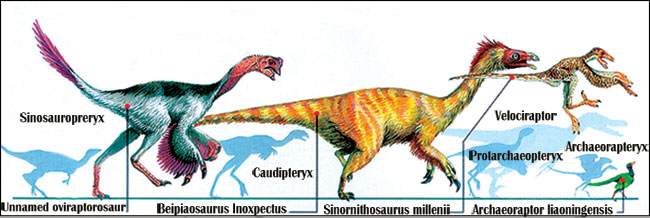 |
For these reasons, the ever-growing trade in fossils represents a serious problem for scientists. Information about the strata where fossils are discovered is constantly being lost because of smuggling. Scientists are also unable to examine research on specimens in private hands, which represents a separate problem. 168
The dino-bird furore has been going on ever since the 1990s and rests on just such a deceptive foundation. Since there is no evidence to support the thesis that birds evolved from dinosaurs, the manufacture and selling of false evidence has become a profitable business, portraying products of commercial fraud as scientific evidence.
The eminent ornithologist Alan Feduccia has the last word:
"All in all, I find the whole dino-bird business a total hoax." 169
 |
Footnotes
152. http://www.bc.edu/bc_org/avp/law/lwsch/journals/bciclr/23_2/02_TXT.htm; The Confuciusornis Sanctus: An Examination of Chinese Cultural Property Law and Policy in Action, by Anne Carlisle Schmidt 
153. Cited June 24, 1998, CNN website www.cnn.com 
154. Jeff Hecht, "Piltdown Bird," New Scientist, Vol. 165, No. 2223, 29 January 2000, p. 12. 
155. "Dino-Kuş Palavra Çıktı," [Dino-Bird is a Fairy-Tale], Hürriyet, 29 March 2001. 
156. Xu Xing, "Response to 'Feathers for T. rex?"," National Geographic, Vol. 197, No. 3, March 2000. 
157. Jeff Hecht, "Piltdown bird," New Scientist, Vol. 165, No. 2223, 29 January 2000, p. 12. 
159. "Open Letter: Smithsonian decries National Geographic's 'editorial propagandizing' of dinosaur-to-bird evolution"; http://www.trueorigin.org/birdevoletter.asp 
160. Tim Friend, "Dinosaur-bird link smashed in fossil flap," USA Today, 25 January 2000 (Emphasis added). 
161. Alan Feduccia, "Plucking Apart the Dino-Birds," Discover, February 2003, Vol. 24, No. 2 (Emphasis added). 
162. Jeff Hecht, "F is for Fake: Only an X-ray will stamp your fossil bargain as authentic," New Scientist, 19 Feb., 2000. 
165. "Scientist disputes fossil is 'missing link' between dinosaurs," Brunswickan Publishing, The Associated Press, 1999; http://www.unb.ca/web/bruns/9900/issue16/sciencetech/ missinglink.html (emphasis added) 
166. Jeff Hecht, "Psst ...wanna Triceratops?," New Scientist, Vol. 152, No. 2060, 14 December 1996, p. 12. 
167. Jeff Hecht, "F is for Fake: Only an X-ray will stamp your fossil bargain as authentic," New Scientist, 19 Feb., 2000. 
168. Jeff Hecht, "Psst ...wanna Triceratops?," New Scientist. 
169. Alan Feduccia, J. David', e-mail, 26 October 1999; http://www.answersingenesis.org/ docs/4208news2-3-2000.asp (Emphasis added). 
